>>>>
https://en.wikipedia.org/wiki/Sankassa
위키영문백과 스크랩 불기2564-06-07
<번역 with 파파고>
산카샤
무료 백과사전인 위키피디아에서
Jump to navigationJump to search
Sankissa
Sankisa
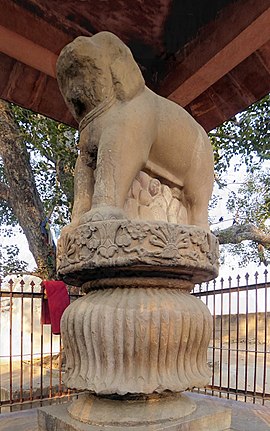
산키사의 코끼리 자본, 3세기 BC
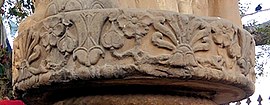
주판의 세부 사항.

인도에서 볼 수 있습니다.인도 지도 보기우타르프라데시 지도 보기모두 표시
위치 인도 우타르 프라 데시 지역의 파루카바드 지역
좌표
 27°20분 02N 79°16분 16초좌표:27°20/29/29/16°/27.33389°N79.27111°E/27.33389;79.27111
27°20분 02N 79°16분 16초좌표:27°20/29/29/16°/27.33389°N79.27111°E/27.33389;79.27111형식 결산
순례자:
부처의
성지

네개의 주요 사이트
보드 가야
쿠시나가르
룸비니
사르나트
4개의 추가 사이트
라지기르
산카샤
Shravasti
Vaishali
기타 사이트
아마라바티
찬다바람
Devadaha
가야
카필바스투
Kesaria
카우샴비
날란다
파탈리푸트라
Pava
바라나시
이후 사이트
아산타 동굴
바라바르 동굴
Bharhut
엘로라 동굴
Lalitgiri
마투라
판다블레니 동굴
Piprahwa
푸슈파기리
라트나 기리
산치
우다야 기리
크라마시라 주
v
t
e
산카사는 인도의 고대 도시였다. 그 도시는 석가 시대에 유명해 졌다. 불교의 한 소식통에 따르면, 사바티에서 30개의 리그가 있었다고 한다[1]. 가우타마 불상의 마하파리니에르바나 왕이 이곳을 개발해 아소카 왕의 유명한 기둥 중 하나를 도시에 설치한 후 코끼리의 수도가 살아 있는 곳이다. 그는 또한 부처의 방문을 기념하는 탑과 절을 지었다. 이 절은 오늘날까지도 존재하며 탑의 잔해는 비샤리 데비 사원으로도 남아 있다. 비사하리 데비라는 이름은 부처의 어머니에게 붙여진 것이라고 합니다.
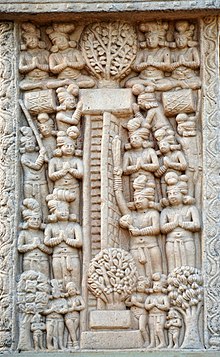
산키사에 있는 트라야스 트림사 하벤에서 나온 부처의 유래[2].
현재 이곳에는 오래 된 유적과 불교 기념물들이 남아 있다. 순례자들은 가기도 힘들고 시설도 많지 않아 방문하는 경우가 드물다. 오랜 시간 후에 알렉산더 커닝햄이 1842년에 그 장소를 발견했습니다. 87년 후, 아나가리카 다라마팔라 경은 정신적인 탐구를 위해 이곳에 왔습니다. 1957년 판디타 마다바비타 위제소마 테로는 몇년간 산키사에 와서 가난한 사람들을 위한 불교 학교를 설립했다.
산키사는 현재 인도 우타프라데시주 파르카하바드 구역의 캄필과 칸나지 사이의 이크쿠마티 강의 북쪽 기슭에 있는 산키사 바산타푸라와 동일시 되어 있다.
내용물
1라마야나 시대의 산키사
2산카사에서의 고대 불교 행사
3건축
4가는 길
5참조
6외부 링크
라마야나 시대의 산키사[편집]
그것은 산카시야 나가르로 알려져 있고, 쿠샤드와자 왕에 의해 통치되었고, 시타의 아버지, 라마야나의 여주인공 그리고 라마 왕의 아내였습니다. 한때 산카시야 나가르의 사악한 왕 수다나 바는 자나카에게 시타의 손을 요구한다. 전쟁이 발발하면 자나카는 패배하고 수다나바를 죽일 수도 있다. 그는 산카시야 왕국을 쿠샤드와자에게 맡긴다.
산카사에서의 고대 불교 행사[편집]
산키사는 고대 주석에 기록된 진술과 주장들로 인해 티피타카에게 명성을 얻었다. 그러나 Tipitaka자체에서는 Sankissa에서 일어날 것으로 예상되는 사건들은 전혀 언급되지 않았다.
산키사에서 부처님이 타바팀사에 있는 아비드함 마피타카를 설교한 후 간담 바 나무 아래서 쌍둥이 기적의 공연에 이어다시 지상으로 돌아오셨다. 부처가 타바팀사를 떠날 시간이 다가오자, 모갈라나는 쿠야 아나타 핀디카가 [3]준 사바티에서 기다리던 군중에게 돌아온다고 발표했다. 그리고 나서 그들은 산키사로 갔다. 부처의 후예가 마하파바라나 축제 날에 일어났다. 사마는 시네루에서 지상으로 부처가 내려올 수 있는 세개의 사다리를 제공하고 있다. 오른쪽에는 신들을 위한 금 사다리가, 왼쪽에는 마하 브라마와 그의 망막용 은 사다리가, 가운데에는 부처를 위한 보석 사다리가 있다. 모인 사람들은 30개의 리그를 돌며 지구를 뒤덮었다. 그 위의 아홉개의 브라마 세계와 그 아래의 아비치 세계에 대한 명확한 전망이 있었다. 부처는 파냐시카, 마탈리, 마하라 브라흐마, 수야마를 동반했다. 사리푸타는 그를 처음으로 환영했다.(업팔라바나가 뒤를 이[4]었고, 부처는 율법을 설교했는데, 그것은 번데기조차 이해할 수 있는 것에서 시작하여 부처만이 이해할 수 있는 것으로 끝을 맺었다.
이 때에, 파로사하사 야타카 왕이 군중들에게 사리푸타의 비할 데 없는 지혜를 선포하라고 선포하였다[1][4]. 부처가 산키사로 내려온 것은 말라나가 아이다 호에서 그의 명성을 보여 줄 기회를 주었고, 아누르두다는 디바카 쿠로, 푸나에서 설교 기술을 보여 주었고, 부처는 사리푸타에게 지혜를 발휘할 기회를 주고 싶어 했다고 한다[1][4][5][6]. 그래서 그는 아무도 답할 수 없는 사리푸타의 질문에 대해 물었다. 사리푸타 수타의 서두 단어는 투시타의 후손을 가리키는 것으로 되어 있다.
산키사 성문이 있는 곳은 세계에서 ' 바꿀 수 없는 '곳 중 하나이다. 모든 부처님들은 아비 하마를 설교한 후에 인간의 세계로 내려온다[7][8]. 산키사에서 제타바나로 갔다[9].

바르후트에 있는 산키사로 하강하라.

간다라의 그레코-BuddhistartoftheGandhara. 산키사로 하강합니다.

2세기 CEMathura의 천국에서 유래.

산키사의 불상전
건축[편집]
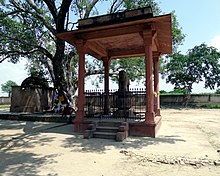
산키사 코끼리는 보호용 지붕 아래에 있다.
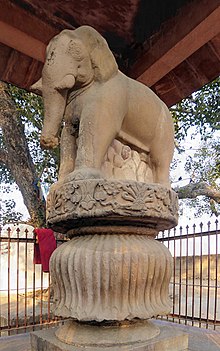
코끼리가 다시 태어날 가능성이 있습니다.
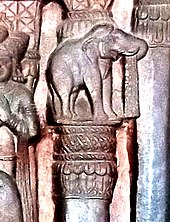
보드 야드 가야마하보디 사원은 또 다른 아소칸 코끼리 기둥으로 기원전 100년 바르후트의 부조에서 묘사되었다.
산키사에 부처의 오른 발이 땅에 닿은 곳에 사당이 세워졌다[10]. 중국 순례자인 쉬안장과 파시안이 이곳을 방문했을 때, 그들은 부처의 후예를 기념하기 위해 고대 사람들이 벽돌과 돌로 만든 사다리 세개를 발견했습니다. 하지만 사다리는 땅에 거의 가라앉을 뻔 했습니다[11][12].
부처님의 시대에 산키사에 사슴 공원이 있었는데, 그곳에서 수헤만타 테라는 부처님의 설교를 들었습니다[13]. 바자푸타 분쟁 때, 소레야에서 사하자티로 가는 도중에 산키사를 거쳤다. 그가 갔던 길은 산키사, 칸나쿠자, 우담바라, 아가라푸라를 통과했다[14]. 그곳에서 발굴 작업을 했지만 중요한 유물은 발견되지 않았다.
마우리아 시대의 코끼리의 수도가 그 장소에서 발견되었다[15].

아소카의 기둥으로 알려진 알려진 수도의 지리적 분포.

산키사 코끼리.

헬레니즘-페르시아 스타일의 아바쿠스[16].
가는 길[편집]

다른 8대 대성당/불교 성지 성지 및 주변의 유명한 도시들과 관련된 산카사 지도
칸푸르 공항에서 차로 250km, 4시간 30분 정도 걸린다.
참조[편집]
 위키 미디어 커먼즈는 산키사와 관련된 매체를 가지고 있다.
위키 미디어 커먼즈는 산키사와 관련된 매체를 가지고 있다.^위로 이동abc: 다암마파다타카타, iii, 224
^ 마셜 p56
^ 비수다치 마가, 페이지 391
^위로 이동abc: 수타 니파타 코벤타리, ii, 570
^ 야타카, 에드 파우스볼, iv, 266
^ 또한 자나 소다나, 사라바미가, 칸다바브야 자타카스를 참조하십시오.
^ 불교 용어 106,247
^ 파파냐 카수단 3, 마자히마 코벤타리 1호
^ 야타카, 에드 파우스볼, i, 193
^ 다 마파다타카타, iii, 227
^ SamuelBeal, 부처의 낭만적인 전설, i, 203
^ 페이엔, 페이지 24
^ Theraga-laCommentary, i, 212
^ 교육 받은 비나야 피타카 올덴 버그, ii, 298K
^ Sen, Dr. A. C. (2008). Buddhist shrines in India. Kolkota: Maha Bodhi Book Agency. p. 63. ISBN 978-81-87032-78-6.
^ 요한 어윈의 연대기, 아소칸 피야르[1]
외부 링크[편집]
불교 용어 사전 산카사의 표제어
중국 순례자 파시안(399-414교류)의 산카시야에 대한 설명
Sankassa비디오 문서(신할레스) 산키사에서 있었던 고대 불교 행사
http://www.palikanon.com/english/pali_names/sa/sankassa.htm
Maps.Google부처님이 쌍둥이 기적을 보여 주는 장소. 야마카 파티하라) -스라바스티
maps.Google부처님이 다우다둥에서 내려오신 곳.-산키사
보여 주
v
t
e
불교의 화제
범주:
>>>>
Sankassa
From Wikipedia, the free encyclopedia
Jump to navigationJump to search
Sankissa
Sankisa

Elephant capital at Sankissa, one of the Pillars of Ashoka, 3rd century BCE

Detail of the abacus.

Shown within IndiaShow map of IndiaShow map of Uttar PradeshShow all
Location Farrukhabad district, Uttar Pradesh, India.
Coordinates
 27°20′02″N 79°16′16″ECoordinates:
27°20′02″N 79°16′16″ECoordinates:  27°20′02″N 79°16′16″E
27°20′02″N 79°16′16″EType Settlement
Pilgrimage to
Buddha's
Holy Sites

The Four Main Sites
Bodh Gaya
Kushinagar
Lumbini
Sarnath
Four Additional Sites
Rajgir
Sankassa
Shravasti
Vaishali
Other Sites
Amaravathi
Chandavaram
Devadaha
Gaya
Kapilavastu
Kesaria
Kosambi
Nalanda
Pataliputra
Pava
Varanasi
Later Sites
Ajanta Caves
Barabar Caves
Bharhut
Ellora Caves
Lalitgiri
Mathura
Pandavleni Caves
Piprahwa
Pushpagiri
Ratnagiri
Sanchi
Udayagiri
Vikramashila
v
t
e
Sankassa (also Sankasia, Sankissa and Sankasya) was an ancient city in India. The city came into prominence at the time of Gautama Buddha. According to a Buddhist source, it was thirty leagues from Savatthi.[1] After the Gautama Buddha's Mahaparinirvana (passing away) king Ashoka developed this place and installed one of his famous Pillars of Ashoka in the city, from which the elephant capital survives. He also built a stupa and a temple commemorating the visit of the Buddha. This temple exists even today and the ruins of the stupa are also present as a temple of Vishari Devi. It is said that the name Visahari Devi is given to the mother of the Buddha.

Descent of the Buddha from the Trayastrimsa Heaven at Sankissa.[2]
Currently it has ruins of old monasteries and Buddhist monuments. It is rarely visited by pilgrims since it is difficult to go to, and there are not many facilities. After a long time Alexander Cunningham (British) discovered the place in 1842. Eighty-seven years later Sir Anagarika Dharmapala (Sri Lanka) came here on spiritual quest. In 1957 Panditha Madabawita Wijesoma Thero (Sri Lanka) came to 'Sankissa' for few years and started a Buddhist school (Wijesoma Widyalaya) for poor people.
Sankissa is now identified with Sankisa Basantapura on the north bank of the Ikkhumati river (Kalinadi), between Kampil and Kannauj, twenty-three miles west of Fatehgarh, twenty-five south of Kaimganj and forty-five north of Kannauj, in Farrukhabad district of Uttar Pradesh state of India.
Contents
1Sankissa at the time of Ramayana
2Ancient Buddhist events at Sankassa
3Architecture
4Getting There
5References
6External links
Sankissa at the time of Ramayana[edit]
It was known as Sankasya Nagar and was ruled by king Kushadhwaja, was a younger brother of Janaka, the father of Sita, the heroine of Ramayana and wife of Lord Rama. Once Sudhanva, supposedly an evil king of Sankasya Nagar, demands the hand of Sita from Janaka. In a war that ensues, Janaka defeats and perhaps kills Sudhanva. He bestows the kingdom of Sankasya to Kushadhwaja.
Ancient Buddhist events at Sankassa[edit]
Sankissa received its fame from statements and claims recorded in the ancient commentaries to the Tipitaka. However, in the Tipitaka itself the events that are supposed to have occurred at Sankissa are not mentioned at all.
It was at Sankissa that (according to the commentaries) the Buddha returned to earth, after preaching the Abhidhamma Pitaka in Tavatimsa, following the performance of the Twin Miracle under the Gandamba tree. As the time approached for the Buddha to leave Távatimsa, Moggallana (Anuruddha, according to Sutta Nipāta Commentary ii 570[3]) announced his coming return to the multitude, who had been waiting at Savatthi, fed by Culla Anathapindika, while Moggallana expounded the Dhamma. They then made their way to Sankissa. The descent of the Buddha took place on the day of the Mahapavarana festival. Sakka provides three ladders for the Buddha's descent from Sineru to the earth: on the right was a ladder of gold for the gods; on the left a silver ladder for Maha Brahma and his retinue; and in the middle a ladder of jewels for the Buddha. The assembled people covered the earth for thirty leagues round. There was a clear view of the nine Brahma worlds above and of Avici (a hell) below. The Buddha was accompanied by Pañcasikha, Mátali, Mahá Brahmá and Suyáma. Sariputta was the first to welcome him (followed by Uppalavanna,[4] and the Buddha preached the Law, starting with what was within the comprehension even of a puthujjana, and ending with what only a Buddha could understand.
On this occasion was preached the Parosahassa Játaka to proclaim to the multitude the unparalleled wisdom of Sáriputta.[1][4] It is said that the Buddha's descent to Sankissa had provided opportunity for Moggallána to show his eminence in iddhi, Anuruddha in dibbacakkhu, and Punna in skill in preaching, and the Buddha wished to give Sariputta a chance of shining in his wisdom.[1][4][5][6] He therefore asked of Sáriputta questions which no one else could answer. The opening words of the Sáriputta Sutta are supposed to refer to this descent from Tusita.
The site of the city gate of Sankissa is one of the "unchangeable" spots of the world (avijahitatthanam). All Buddhas descend at that spot to the world of men after preaching the Abhidhamma.[7][8] From Sankissa the Buddha went to Jetavana.[9]

Descent to Sankissa in Bharhut.

Descent to Sankissa, in the Greco-Buddhist art of Gandhara.

Descent from Heaven, 2nd century CE, Mathura.

The Buddha Preaching in Sankissa
Architecture[edit]

The Sankissa elephant under a protective roof.

Possible reconstitution of the elephant.

The Bodh Gaya Mahabodhi Temple pilar, another Ashokan elephant pillar, portrayed in a Bharhut relief, 100 BCE.
A shrine was erected on the spot where the Buddha's right foot first touched the ground at Sankissa.[10] When the Chinese pilgrims, Xuanzang and Faxian, visited the place, they found three ladders, which had been built of brick and stone by the ancients, to commemorate the Buddha's descent, but the ladders were nearly sunk in the earth.[11][12]
There was, in the Buddha's time, a deer park at Sankissa where Suhemanta Thera heard the Buddha preach.[13] During the Vajjiputta controversy, Revata Thera, on his way from Soreyya to Sahajati, went through Sankissa. The road he took passed through Sankissa, Kannakujja, Udumbara and Aggalapura.[14] The excavations carried out in the place did not reveal any artifacts of importance.
An elephant capital from the period of the Mauryas was found at the site.[15]

Geographical spread of known capitals of the pillars of Ashoka.

Sankissa elephant (drawing).

Abacus in hellenistico-persian style.[16]
Getting There[edit]

Map of Sankassa in relation to other Eight Great Places Buddhist pilgrimage sites and notable nearby cities
Its about 250 km and 4 hours 30 minute drive from Kanpur Airport
References[edit]
 Wikimedia Commons has media related to Sankissa.
Wikimedia Commons has media related to Sankissa.^ Jump up to:a b c Dhammapadatthakathā, iii, 224
^ Marshall p.56
^ cf. Visuddhi magga, p. 391
^ Jump up to:a b c Sutta Nipāta Commentary, ii, 570
^ Jātaka, ed. Fausboll, iv, 266
^ see also Jhánasodhana, Sarabhamiga, and Candábha Játakas
^ Buddhavamsa Commentary 106, 247
^ Papañca Sūdanī, Majjhima Commentary i 371
^ Jātaka, ed. Fausboll, i, 193
^ Dhammapadatthakathā, iii, 227
^ Samuel Beal, Romantic Legend of the Buddha, i, 203
^ Fa Hien, p. 24
^ Theragāthā Commentary, i, 212
^ Vinaya Pitaka, ed. Oldenberg, ii, 299f
^ Sen, Dr. A. C. (2008). Buddhist shrines in India. Kolkota: Maha Bodhi Book Agency. p. 63. ISBN 978-81-87032-78-6.
^ John Irwin, The true chronology of Ashokan Pillars [1]
External links[edit]
Entry on Sankassa in the Buddhist Dictionary of Pali Proper Names
Description of Sankasya by the Chinese pilgrim monk Faxian (399-414 AC)
Sankassa Video Documentary (in Sinhalese) Ancient Buddhist events at Sankissa
http://www.palikanon.com/english/pali_names/sa/sankassa.htm
maps.google The place where Lord Buddha show Twin Miracle (Pali:Yamaka Patihara). - Sravasti
maps.google The place where Lord Buddha came down from Daowadung. - Sankisa
show
v
t
e
Topics in Buddhism
Categories:
Ancient Indian cities
History of Uttar Pradesh
Buddhist pilgrimage sites in India
Places in the Ramayana
댓글 없음:
댓글 쓰기
What do you think is the most important?
Do you know why this is the most important?